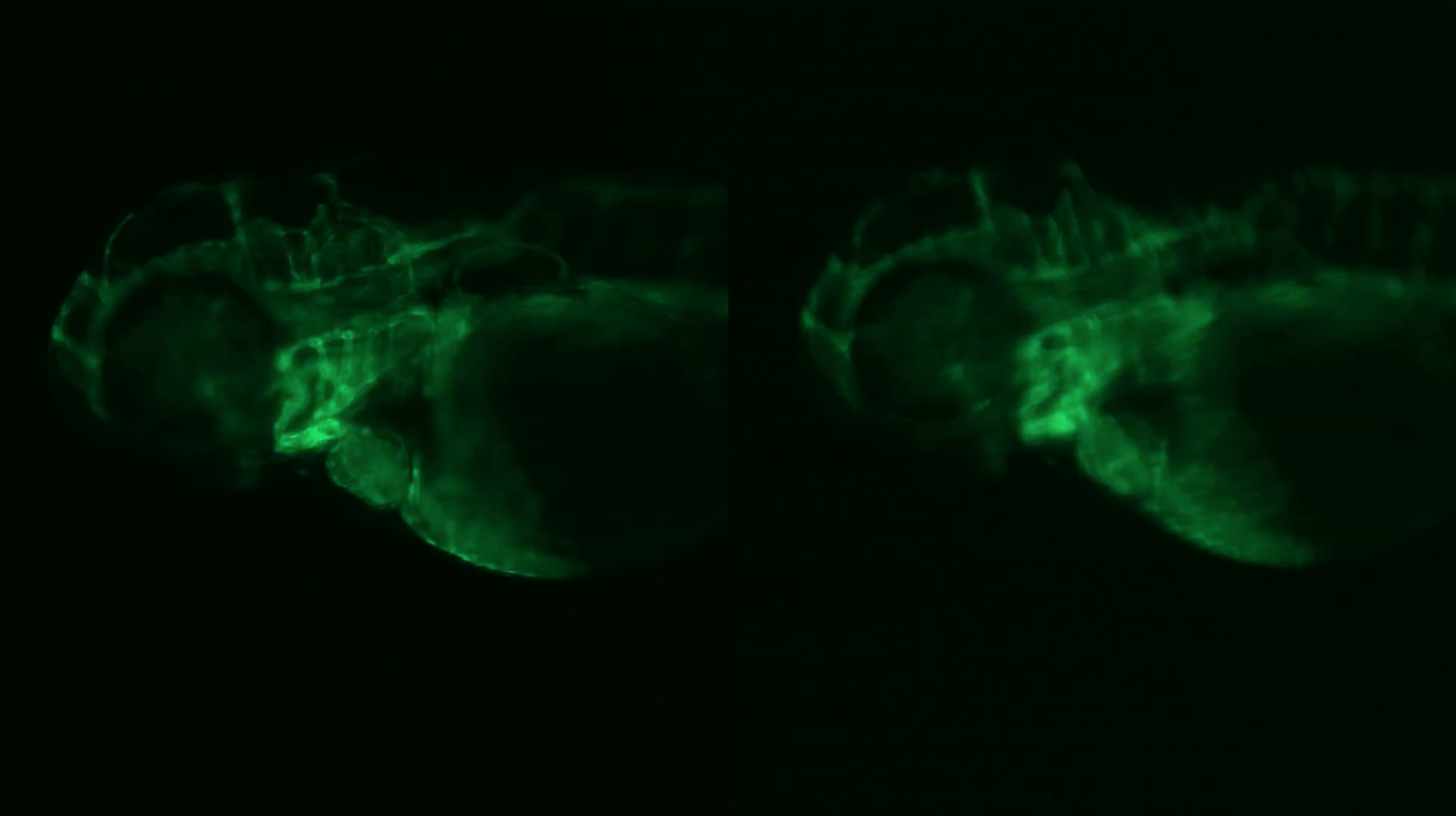Do you sometimes feel like you are fishing in the dark because you are looking for fluorescence signals that are increasingly faint and weak? Brightness and high resolution images are a must in modern developmental biology and research.
Leica Microsystems has developed the M205 FA and M205 FCA fluorescence stereo microscopes to enable you to detect transgenic expression like GFP and mCherry in early stages, allowing you to select the right sample to successfully base your studies on.
Until now, you probably had to switch between two different systems: one for fast screening with a manual zoom that is intuitive to maneuver and a high-end solution to see and capture the faintest signals in an image.
The Leica M205 FCA fluorescence stereo microscope unites both worlds and combines super-fast manual screening with high-end imaging capabilities.

The Leica M205 FA opens up a new world of research in fluorescence microscopy, for instance when working in a sterile cabinet.
To detect even the faintest signals of your sample, you need an energy-rich excitation light to give a bright fluorochrome signal.
However, the excitation light may cause reflections that blur the black background and compromise the detection of fluorescence signals.
Leica’s TripleBeam technology completely eliminates this background “noise” by introducing a third optical zoom. This separates the fluorescence excitation light from the two observation channels and omits the need for a dichroic mirror.
The result is a clear and strong fluorescence signal against a noise-free, black background.
Do you think that high resolution and maximum depth of field are irreconcilable opposites in microscopy? We prove they are not! Leica Microsystems' FusionOptics technology overcomes optical limitations by using the two beam paths for different tasks:
The result: you perceive an image with outstanding richness of detail and exceptional depth of field at the same time
Recognizing fine details is vital in research especially when working with small organisms. The Leica M205 FA and M205 FCA can achieve a resolution of 1279 lp/mm or 0.78 µm based on the resolution limit defined in ISO18221*.
The 2.0x PlanApo objective is an optical masterpiece. It has a maximum aperture of 0.35 – that’s the highest numerical aperture (NA) that has ever been achieved with a stereo microscope. This is smaller than a tenth of the diameter of a human red blood cell.
*M205 FA, 2x PlanAPO objective, camera adapter 0.63x, DMC4500 camera in full frame mode, Apple 5K with 27” monitor.

Image Coding provides convenient, reproducible settings for quick, easy documentation.
The integrated encoding transmits both the magnification and the position of the iris diaphragm to the software in real time. A scale bar is overlayed into the live image and updated when the magnification is changed. When an image is stored, all the settings are saved with the image and can be recalled at any time.
With the Leica PLAN APO 2.0x CORR Objective, the refractive index can be adjusted – this way you will have pin-sharp images even if there is a water column of 5 mm between your sample and the objective. The objective enables users to observe and document samples as if the water did not exist.
When observing samples immersed in a watery solution, structures tend to blur especially in high magnification. This is due to the refractive index mismatch of air (index = 1) and water (index = 1.3). Potentially interesting or important structures may be easily misinterpreted because of spherical aberrations that may occur, as regular objectives are dedicated to the use with samples surrounded by air only.


Among the aquatic model organisms used in molecular and developmental biology the most prominent are the zebrafish (genus species: Danio rerio), medaka or japanese rice fish (genus species: Oryzias latipes), and african clawed frog (genus species: Xenopus laevis). This report gives useful information to scientists and technicians which can help improve their daily laboratory work by making the steps of transgenesis, fluorescent screening, and functional imaging more efficient.

For samples/specimens immersed in a liquid or embedded in a polymer, high quality microscopic observation can be hindered as a result of spherical aberration. An objective which can correct for refractive index mismatch allows images with greatly reduced spherical aberration and sharper focus to be obtained.
For scientists, technicians, and teachers working with the worm C. elegans in the research lab or classroom, this report is intended to give useful information to help improve their daly work. The aim is to make the work steps of worm picking, transgenesis, RNA interference, screening, and functional imaging efficient. It also details the various possibilities for equipping a research worm lab or biology classroom/teaching lab explaining worm methods.

For scientists and technicians working with fruit flies, most often genus Drosophila, this report is intended to give useful information to help improve daily laboratory work by making the steps of fly pushing, fluorescent screening, dissection, and documentation/imaging more efficient. It also details various possibilities for properly equipping or stocking a fly lab.
Hiện tại chưa có ý kiến đánh giá nào về sản phẩm. Hãy là người đầu tiên chia sẻ cảm nhận của bạn.